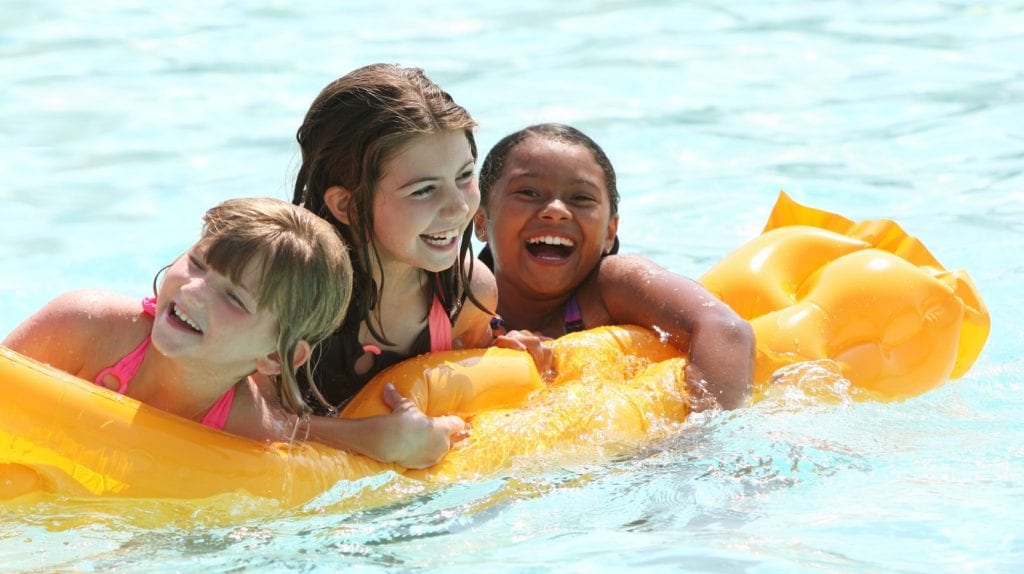
Photo: Getty/Image/kirin_photo
Picture this — you’re poolside, lounging beneath a cabana, barefoot with drink in hand, but you’re not on vacation. You’re home.
An increasingly popular new-home feature, pools are reflective of the attainable luxury newly built homes and master-planned communities provide. No longer a dream deferred, the backyard pool is a dream for every man.
But with pools come safety hazards for kids, pets and even adults. According to the Center for Disease Control (CDC), about 10 people die of unintentional drowning each day, of which two are children below the age of 14. This makes drowning the fifth leading cause of unintentional death in the United States.
A startling statistic, it’s also a preventable one at home. Taking the proper precautions means you don’t have to opt out of the home pool option, but can instead enjoy your own oasis with peace of mind.
Be Aware of Your Surroundings
The first thing you should know, says Safety 1st consumer safety expert Julie Vallese, is that it’s not just your own pool you should be worried about. Access to your neighbor’s pool, a community pool or even a small, inflatable pool poses a potential threat. “If a child is missing and there is a pool nearby, look there first,” says Vallese, as this can be the difference between life and death.
Learn to Swim
Nothing is more important in the realm of water safety than learning how to swim. “Learning to swim is a life skill and should be taught as early as a parent is comfortable and a child is able to learn,” Vallese says. Children as young as six months can receive water orientation training.
While you can control the physical protection of your own backyard pool with barriers and alarms, knowing how to swim can help keep you and your family safe in an unfamiliar or unprotected aquatic environment.
Establish Pool Rules
Laying down ground rules for the pool is an important step in water safety. Even if all family members know how to swim, pool rules can help prevent secondary water-related accidents like slipping and falling. In general, the rules that exist at a public pool should also apply at home. This includes rules such as no running, shoving and horseplay. You can enforce these rules by implementing a “time out” if rules aren’t followed.
Practice Supervision
“If … children are in the pool, your eyes and attention are there as well,” says Vallese, no questions asked. Don’t think you can run in the house for even just a minute, she says. If need be, it’s best to have the kids get out of the pool and take a break while you run inside.
A good way to maintain constant vigilance is to “identify a responsible adult as the pool watcher for a specific period of time,” says Vallese. During this time the pool watcher agrees not to engage in other activities like texting, reading, napping or tending the BBQ. “These are things they can do when they pass off the responsibility to the next water watcher.”
For older, well-trained swimmers, the use of the buddy system can replace close parental supervision. However, nobody, no matter how well-trained, should swim alone.
Have Pool Safety Equipment on Hand
You should always keep U.S. Coast Guard-approved life jackets on hand. Even if your kids already know how to swim, it’s a good idea to keep these around for any house guests who may need one.
In a worst case scenario, you’ll need emergency flotation devices and medical training at the ready. “Every pool should have a life saver and a shepherds hook,” says Willan Johnson, CEO of VivoPools, a pool care service and management company. “These pool items will help in pulling distressed swimmers to safety.”
Additionally an adult member, or members, of the household should be trained in CPR and first aid. It’s important that a person with this medical training be on hand at all times, even if they aren’t immediately supervising. For worst case scenarios, you should also keep a phone at the ready to dial 911.
Install a Pool Fence and Cover
One important aspect of pool safety involves protecting people and pets from entering the pool unsupervised. “An unsupervised child (or pet) can easily wander into the backyard, accidentally fall or purposely jump in and endanger themselves,” says Johnson.
Your first line of defense is to “install a pool fence that is at least 48-inches high and has a self-closing, self-latching, child-resistant gate.” If a child can’t access the pool by him- or herself, this removes the threat of accidental drowning.
However, even a fence isn’t a completely foolproof deterrent, so you should also make sure the pool cover is on when not in use.
Set Up an Alarm System
An alarm system is a great way to know when danger is afoot without having to hover over your kids. You can set up pool alarms to detect movement in the pool area or let you know when someone opens the pool gate, says Johnson.
Another option — especially for children who can’t swim — is to have them wear an anti-drowning wristband. Much like a bracelet or watch, these devices will sound when wet, so you can be immediately alerted.
Remove Toys from Pool After Use
Leaving toys in the pool is a dangerous temptation for kids. The appeal to reach out and grab toys from the pool may lead to your child accidentally falling in, says Vallese. Clearing the pool of toys after swimming removes this temptation and can help kids to develop responsibility and discipline to clean up after themselves.

Ashley Steel is a former SEO analyst for Builders Digital Experience (BDX).
She was previously a staff writer and editor for New Home Source, where she wrote about a variety of topics, from helping Realtors understand how to assist clients in choosing new home options to helping consumers find home design inspiration in a variety of places including a chic industrial-style bar to chicken coops.
Steel is a 2013 graduate of the University of Texas at Austin with a double major in Latin American Studies and Spanish. Previous to joining BDX, she worked with Latinitas, a nonprofit group that aims to encourage Latino youth to explore the fields of media and technology.

 4 Landscaping Trends to Inspire Your Ultimate Backyard
4 Landscaping Trends to Inspire Your Ultimate Backyard